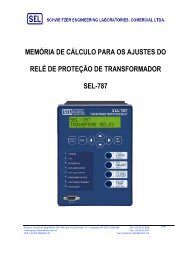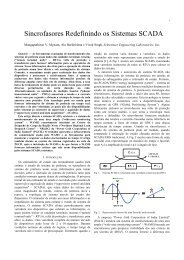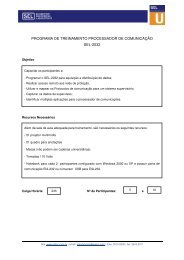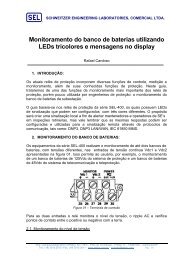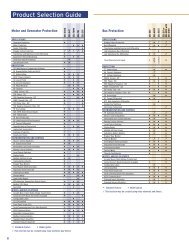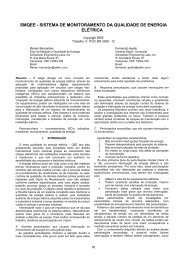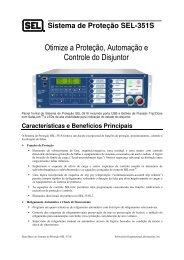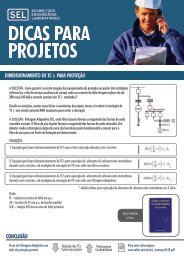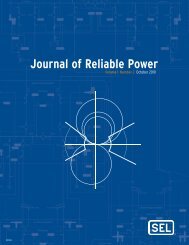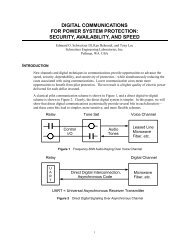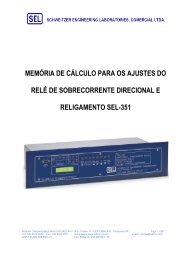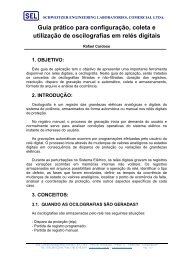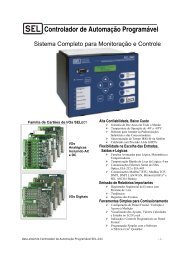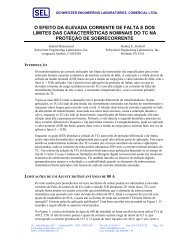Journal of Reliable Power - SEL
Journal of Reliable Power - SEL
Journal of Reliable Power - SEL
You also want an ePaper? Increase the reach of your titles
YUMPU automatically turns print PDFs into web optimized ePapers that Google loves.
Both P and Q are two-input phase angle comparators. The<br />
P-comparator has a maximum “torque” when A and B are in<br />
phase. The Q-comparator has maximum torque when the two<br />
inputs are in quadrature. The Q-comparator is essentially the<br />
same as the induction cylinder with current inputs.<br />
In digital relays, it is easy to save the torques (P, Q). We<br />
can use the sign <strong>of</strong> the result (analogous to the cup rotation<br />
direction) as well as the magnitudes for tests involving fault<br />
type, sensitivity, etc.<br />
C. Coincidence-Timing Two-Input Phase Comparator<br />
To test the phase angle between sinusoids a and b, we can<br />
first convert a and b to square waves to derive signals A and<br />
B. The time coincidence <strong>of</strong> A and B is shown in Figure 2.<br />
We need to test the angle between δV and V p . When the<br />
angle is 90°, the relationship between δV and V p is any point<br />
on the circle, as shown in Figure 3.<br />
IX<br />
r • Z • I<br />
V = r • Z • I – V<br />
V<br />
Vpol<br />
a<br />
A<br />
Characteristic<br />
Timer, T<br />
IR<br />
AND<br />
T<br />
Output y<br />
b<br />
B<br />
Figure 3: Mho Element Derivation<br />
Figure 2:<br />
Coincidence-Timing Two-Input Comparator Logic<br />
One advantage <strong>of</strong> this comparator is the characteristic timer<br />
setting T controls the phase angle <strong>of</strong> coincidence required to<br />
obtain an output y, so we can easily synthesize mho,<br />
lenticular, and tomato characteristics.<br />
D. Application <strong>of</strong> Digital Product Phase Comparator<br />
A mho element tests the angle between a line-dropcompensated<br />
voltage and a polarizing or reference voltage.<br />
Let δV = (r • Z • I – V), where δV is the line-drop<br />
compensated voltage<br />
Z = replica line impedance<br />
r = per-unit reach in terms <strong>of</strong> the replica impedance<br />
I = measured current<br />
V = measured voltage<br />
V p = polarizing voltage.<br />
Let us test δV and V p using a digital product comparator.<br />
Which one should we use—sine or cosine Since balance (or<br />
zero torque) is at 90°, we need to use the cosine comparator,<br />
because cos 90° = 0.<br />
Let P = Re[δV • Vp*]<br />
Then: P > 0 represents the area inside the circle <strong>of</strong> reach<br />
r • Z<br />
P = 0 represents the circle itself<br />
P < 0 represents the area outside the circle <strong>of</strong> reach<br />
r • Z<br />
(Re = real portion)<br />
E. Characteristic-Mapping Approach<br />
Traditionally, one comparator is required for each zone,<br />
and for each voltage and current input combination. We can<br />
achieve significant economy in processing with no loss in<br />
performance by mapping the points on any mho circle <strong>of</strong> reach<br />
r onto a unique point on a number line.<br />
Recall the mho comparator, P:<br />
P = Re[δV • V p *]<br />
= Re[(r • Z • I – V) • V p *]<br />
For any V, I, V p combination on a circle <strong>of</strong> reach r, P is<br />
zero. This condition <strong>of</strong> balance is:<br />
0 = Re[(r • Z • I – V) • V p *]<br />
Solving for r yields in an equation which is the reach <strong>of</strong> the<br />
mho circle corresponding to the condition <strong>of</strong> balance:<br />
*<br />
Re ( V • Vp<br />
)<br />
r =<br />
(1)<br />
*<br />
Re ⎡Z • I • V ⎤<br />
⎣ p ⎦<br />
Distance Relay Element Design | 5



